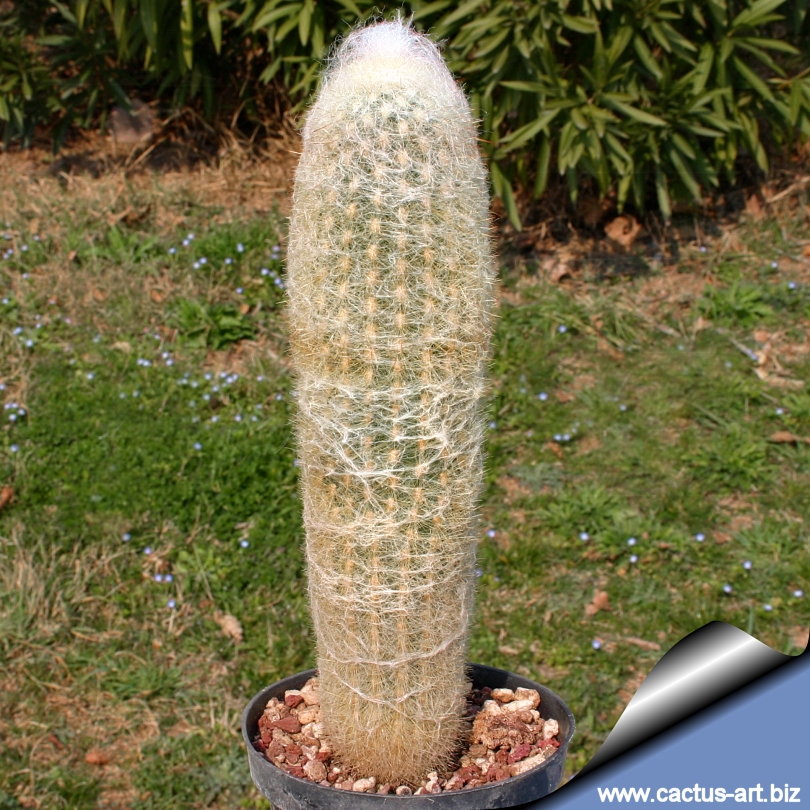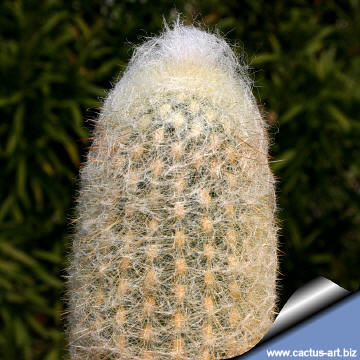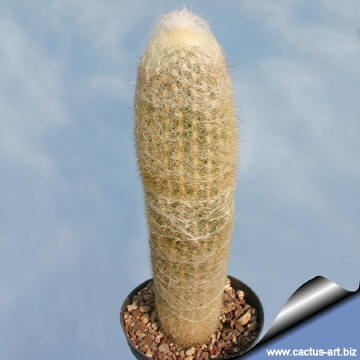|
|
|

Espostoa lanata makes a beautiful individual specimen with
hair as fine as the finest spun silk and a lustre which can only be
called sheer.
|
|
Description: Slow growing
tree shaped cactus branching at the top with age, 1,5 to 7 m tall. Like
Cephalocereus (the Old Man of Mexico) it is a densely
hairy species, covered by a warm woolly coat and well adapted to high
altitudes, the main difference is the presence of sharp spines on
Espostoa. It is wide spread in in habitat and quite variable in
size and spines for this reason it has received several names.
Stems: Cylindrical, erect or spreading, 6-10 cm in diameter from
a short trunk (approx 1 m tall up to 20 cm in diameter).
Ribs: 18-25, low rounded, separated by linear furrows, approx 5-8
mm tall.
Areoles: Elliptical, closely set, 7-10 mm apart, almost concealed
by white or yellowish hairs and spines. The hairs are neatly brushed,
cunningly concealing the sharp spines that are a trap to the unwary.
Central spines: Absent or sometime1, 1-2.5 cm long
Radial spines: 30-40 acicular, spreading, reddish or yellowish
brown, turning grey as they age, 3-8 mm long.
Flowers: The flowers arises from a lateral pseudocephalium up to
1 m long, 4-5 ribs wide, with brown or grey spines and wool contrasting
with the snow-white spines on the rest of the body. The flowers are
nocturnal, funnelform, nearly hidden by the wool, up to 5,5 cm long and
3,5 cm in diameter, white to purple. Small scales on the ovary and
flowers tube, have long silky, caducous, hairs.
Blooming season: Late spring, early summer.
Fruit: Top shaped, near spherical approx 2,5 cm in long and in
diameter, purplish-red, very juicy, sweet and edible. The colourful
fruit project from the woolly mass of the lateral cephalium and are a
startling sight.
Seeds: Very small, black and shining.
|
|
 |
 |
|
Advertising
|
|
|
|
|
Family:
Cactaceae (Cactus
Family)
Scientific name: Espostoa
lanata (Kunth) Britton & Rose
Origin: Southern Ecuador, northern Peru
Habitat: Mainly on the west slopes of the
Andes
Conservation status: Listed in
CITES appendix 2.
Common English Names include: Peruvian Old Man Cactus ,
Cotton Ball Cactus, Snowball Cactus, Snowball Old Man
Etymology:T he name of the genus, Espostoa, comes from the
Peruvian botanist Nicholas Esposto.
Synonyms:
- Cactus lanatus Kunth 1823
- Cereus lanatus (Kunth) A.P. De
Candolle 1828
- Pilocereus lanatus (Kunth) F.A.C.
Weber 1898
- Cleistocactus lanatus (Kunth)
F.A.C. Weber 1904
- Oreocereus lanatus (Kunth)
Britton & Rose 1916
Heterotypic synonyms:
- Pilocereus dautwitzii Haage 1873
- Cereus dautwitzii (Haage) Orcutt
1902
- Espostoa dautwitzii (Haage) Borg
1937
- Cereus sericatus Backeberg 1931
- Cereus lanatus ssp. sericatus (Backeberg)
Werdermann 1937
- Espostoa sericata (Backeberg)
Backeberg 1935
- Espostoa lanata var. sericata
- Espostoa procera Rahu & Backeberg
1957
- Espostoa laticornua Rahu &
Backeberg 1957
Espostoa is considered by some
authors a monotypic genus, by others it include 4 species.
|
|
|
|
Cultivation:
It is easy to grow and cold hardy as low as -12°C (or less). Need a
fertile, well drained soil mix. Water the plants well and allow them to
dry before watering again. This species seems to do better with a little
more water than most cacti. During the
growing season fertilize them monthly with a balanced fertilizer
Sun Exposure: Outside
full sun, inside needs bright light, and some direct sun. During
winter month, put them in a cool luminous place and encourage them to
enter winter dormancy by withholding water and fertiliser over the
winter as they will etiolate, or become thin, due to lower levels of
light. They are susceptible to fungal diseases if overwatered, but are
not nearly as sensitive as many other cacti, especially in warm weather.
If kept damp through cold periods,
they will invariably suffer.
Espostoa produces noticeable amounts of growth each year if
kept well fed and watered throughout the warmest months, particularly if
it has been acclimatised to accept full sun. Once this cactus is
established it can easily produce 20 cm of growth every year.
Propagation: Cutting or
from seed. The seeds are quite easy to germinate and grow. Their main
requirements consist of high humidity levels, free-draining soil mix,
and enough water, light, and nutrition
Traditional uses:
Woolly hairs of the cephalia have been used for pillow filling in Peru.
|
|

 |
|